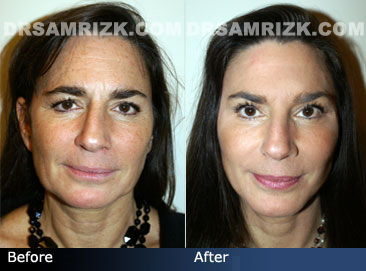Facelift, also called rhytidectomy, is a common surgical procedure performed to make facial skin and muscles tighter. One of the decisions a patient undergoing this procedure must make (in conjunction with his or her facial plastic surgeon) is what type of sedation or anesthesia will be used during surgery.
Anesthesia means “without sensation.” In medicine, the term refers to the use of medicines and techniques to block pain and limit movement so that medical procedures such as surgery can be performed.
There are generally three types of anesthesia used for plastic surgery: local (including topical), intravenous (IV) or conscious sedation, and general anesthesia. These types are often combined. The kind of sedation used by your surgeon will depend on certain factors, such as how invasive your facelift procedure is and your input into the process.

Facelift By Facial Plastic Surgeon Dr. Sam Rizk
Local Anesthesia
Topical anesthesia refers to medicine that numbs the surface of a body part. The effects of topical products are reversible and commonly last about 30 minutes. Unless the patient is allergic to the drug, there are unlikely to be any side effects.
Local anesthesia refers to (generally) injected medication that numbs a small area of skin and deeper tissue. Sometimes, a doctor will use a topical anesthetic to numb the skin so that an injection of local anesthesia can be given but not felt. Local anesthesia blocks pain and causes muscles to be extremely relaxed, allowing the surgeon to work.
Local anesthesia can be combined with an oral sedative (such as Valium). The patient is awake, but is not anxious and does not feel any pain.
Facelifts done with any type of anesthesia outside of general anesthesia do not require an anesthesiologist, which reduces costs. However, the lack of an anesthesiologist means that the surgeon, or another person on the surgical team, is responsible for continued monitoring of the sedation throughout the procedure.
Numbness from local anesthetics might persist for some time after surgery. Rarely, very high doses of local anesthesia can get into the bloodstream and affect body functions such as breathing, heartbeat and blood pressure.
Conscious Sedation
Conscious sedation, formerly called twilight sedation or twilight sleep, is a deeper form of sedation than local anesthesia. The patient is given a medicine for relaxation and an analgesic to block pain. Some forms of conscious sedation involve shots into muscles, but mainly, intravenous lines (needles into veins) provide the medicine to the body. The patient is sleepy but may still be awake and may be able to respond to commands. With this type of anesthesia, the patient controls his or her own breathing. There is no need for intubation (the breathing tube down the throat), but the patient might have an oxygen mask to provide extra oxygen. Blood pressure and breathing are likely to be slower. Vital signs will be monitored continuously throughout the procedure.
Side effects that may be associated with conscious sedation include headache, nausea, and sleepiness. These might last for several hours after a facelift procedure.
General Anesthesia
General anesthesia is the most complete way to block pain and sensation. A facelift patient under general anesthesia is sedated, unconscious and immobile. General anesthesia blocks pain and prevents the patient from remembering what happened during the procedure. General anesthetics can be inhaled or injected intravenously. An anesthesiologist will always be present when facelifts are done under general anesthesia. The use of general anesthesia means that patients may need respiratory or cardiovascular support. A breathing tube or other airway device may be inserted after the patient is sedated.
After general anesthesia, some patients find that they have a kind of “drug hangover,” a feeling of sluggishness that persists for some time after the surgery. Others find themselves feeling nauseated or actually vomiting. Some people have sore throats due to the breathing tube placement, or experience dry mouth. Shivering and a feeling of coldness is also a possible side effect. The general anesthesia may also cause patients to experience impaired judgment and/or coordination. The effects might last for longer than a day, but newer anesthetics have improved results.
The choice of moderate or deep sedation or general anesthesia depends on how extensive the facelift is, the patient’s feelings about anesthesia/sedation, and the advice of the surgeon and/or anesthesiologist. Other factors include the patient’s medical history, current health status and the location where the facelift will take place.
Facial plastic surgeons have successfully used combinations of local anesthesia and conscious sedation and local anesthesia plus oral anti-anxiety drugs like Valium to do both facelifts and mini lifts. Some patients will flat out refuse general anesthesia, while others will seek to be entirely “out” because they want to avoid the possibility of waking up or remembering any part of the procedure. Some surgeons prefer general anesthesia, especially for more complicated facelifts, because the surgeon can focus solely on operating and leave the sedation to the anesthesiologist.
For more information on sedation and facelifts, contact Dr. Rizk’s office today.















